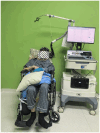A study on resting-state functional near-infrared spectroscopy in patients with different outcomes of prolonged disorders of consciousness
- PMID: 40529439
- PMCID: PMC12171453
- DOI: 10.3389/fneur.2025.1533853
A study on resting-state functional near-infrared spectroscopy in patients with different outcomes of prolonged disorders of consciousness
Erratum in
-
Correction: A study on resting-state functional near-infrared spectroscopy in patients with different outcomes of prolonged disorders of consciousness.Front Neurol. 2025 Jun 27;16:1642987. doi: 10.3389/fneur.2025.1642987. eCollection 2025. Front Neurol. 2025. PMID: 40661244 Free PMC article.
Abstract
Background: To explore the characteristics of resting-state functional connectivity in patients with different outcomes of prolonged disorders of consciousness (pDoC) by studying resting-state near-infrared imaging in patients with pDoC.
Methods: 60 patients with pDoC were processed with resting-state near-infrared imaging and divided into unresponsive wakefulness syndrome/vegetative state (UWS/VS) group, minimally conscious state (MCS) group and escape minimally conscious state (EMCS) group according to the post-treatment state of consciousness, to analyze the difference of resting-state functional connectivity in patients with different outcomes of patients with pDoC.
Results: Functional connectivity (FC) between frontal lobe and left occipital lobe, frontal lobe and right occipital lobe, and left and right occipital lobes decreased in the UWS/VS group compared with the MCS group; functional connectivity between frontal lobe and left occipital lobe, frontal lobe and right occipital lobe, and left and right occipital lobes decreased in the UWS/VS group compared with the EMCS group; functional connectivity did not show any significant difference between the EMCS and MCS groups; and functional connectivity was more centralized in the MCS group and EMCS group.
Conclusion: Different outcomes of patients with pDoC have different degrees of decline in functional connectivity between frontal lobe and occipital lobe and between occipital lobe, resting-state functional near-infrared spectroscopy has a certain reference significance for the prognosis of patients with pDoC, and it is helpful for exploring the exploration of the conscious residual brain areas.
Keywords: functional connectivity; functional near-infrared spectroscopy; outcomes; prolonged disorders of consciousness; resting-state.
Copyright © 2025 Liang, Liang, Li, Wang, Bi, Xue and Jiang.
Conflict of interest statement
The authors declare that the research was conducted in the absence of any commercial or financial relationships that could be construed as a potential conflict of interest. The handling editor DW declared a past co-authorship with the author WJ.
Figures






Similar articles
-
Local Neuronal Activity and the Hippocampal Functional Network Can Predict the Recovery of Consciousness in Individuals With Acute Disorders of Consciousness Caused by Neurological Injury.CNS Neurosci Ther. 2024 Nov;30(11):e70108. doi: 10.1111/cns.70108. CNS Neurosci Ther. 2024. PMID: 39508317 Free PMC article.
-
EEG microstate analysis in children with prolonged disorders of consciousness.Sci Rep. 2025 Jul 18;15(1):26148. doi: 10.1038/s41598-025-11038-2. Sci Rep. 2025. PMID: 40681705 Free PMC article.
-
Functional connectivity characteristics of epilepsy with anxiety: A resting-state functional near-infrared spectroscopy study.Medicine (Baltimore). 2025 May 30;104(22):e42660. doi: 10.1097/MD.0000000000042660. Medicine (Baltimore). 2025. PMID: 40441208
-
Alterations in brain functional connectivity in patients with mild cognitive impairment: A systematic review and meta-analysis of functional near-infrared spectroscopy studies.Brain Behav. 2024 Apr;14(4):e3414. doi: 10.1002/brb3.3414. Brain Behav. 2024. PMID: 38616330 Free PMC article.
-
Functional connectivity of hippocampus in temporal lobe epilepsy depends on hippocampal dominance: a systematic review of the literature.J Neurol. 2022 Jan;269(1):221-232. doi: 10.1007/s00415-020-10391-8. Epub 2021 Feb 10. J Neurol. 2022. PMID: 33564915
References
-
- Giacino JT, Katz DI, Schiff ND, Whyte J, Ashman EJ, Ashwal S, et al. Practice guideline update recommendations summary: disorders of consciousness: report of the guideline development, dissemination, and implementation Subcommittee of the American Academy of neurology; the American congress of rehabilitation medicine; and the National Institute on Disability, Independent Living, and Rehabilitation Research. Neurology. (2018) 91:450–60. doi: 10.1212/WNL.0000000000005926, PMID: - DOI - PMC - PubMed
-
- Enrico A, Francisco G, Carol PD, Vanhaudenhuyse A, Lesenfants D, Boveroux P, et al. Posterior cingulate cortex-related co-activation patterns: a resting state FMRI study in propofol-induced loss of consciousness. PLoS One. (2014) 9:e100012. doi: 10.1371/journal.pone.0100012, PMID: - DOI - PMC - PubMed
LinkOut - more resources
Full Text Sources

